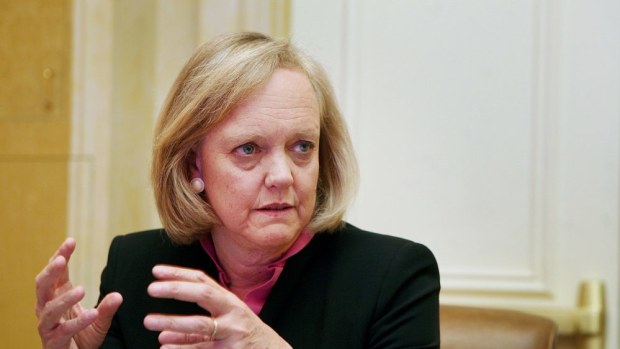Is Hewlett-Packard shrinking to greatness?
Hewlett-Packard has made some of the worst acquisitions in corporate history.
Fortunately, Meg Whitman says she is a "devotee of focus". Last year, the then chief executive split the group in two: legacy HP, selling printers to consumers, and HP Enterprise, selling servers and services to companies. This was supposed to free HPE to find growth through acquisitions – a nerve-racking prospect.
Instead, from her new seat at HPE, Ms Whitman has found more non-core assets to prune – including Tuesday's spin-off of the IT services unit, which is to be merged with its smaller public rival Computer Sciences Corp to create a consulting giant with $26 billion in revenues. Only the churlish would note that the deal puts an $8.5 billion valuation on a services business formed, in part, of Electronic Data Systems, which cost HP $14 billion in 2008. Ancient history.

Hewlett-Packard chief executive Meg Whitman is selling assets. Bloomberg
Shares in HPE rose 10 per cent and CSC rose more than 20 per cent in after-hours trading. HPE and CSC shareholders will each own 50 per cent of the new company.
If getting smaller gets the plaudits, why not keep lopping bits off? The software unit is a good candidate. In quarterly results reported alongside the deal, HPE said software revenues fell 13 per cent year on year to $1.5 billion. It is the smallest, subscale part of the remaining company. No conceivable sale would allow HPE to recoup much of the $11 billion HP wasted in its 2011 buy of Autonomy, the British software group, but that has been largely written off.
The tricky thing for any disposal is doing it as efficiently as the latest deal. HPE and CSC promise $1 billion of cost savings in the first year. The two companies have 95 data centres, which can be pruned, as can outsourcing operations in India and China.
Most important, and harder to replicate, is the tax-free nature of the deal using a structure known as a Reverse Morris Trust, which combines a spin-off and merger. The devotee of focus should, nonetheless, look for more opportunities to get smaller.
Financial Times
Subscribe to gift this article
Gift 5 articles to anyone you choose each month when you subscribe.
Subscribe nowAlready a subscriber?
Latest In Technology
Fetching latest articles